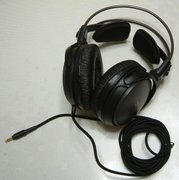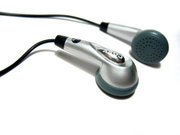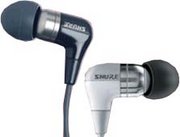Headphones (also known as earphones, stereophones, headsets, or the slang term cans) are a pair of transducers that receive an electrical signal from a media player or receiver and use speakers placed in close proximity to the ears (hence the name earphone) to convert the signal into audible sound waves.
Headphones date from the beginnings of the history of the telephone and the radio. The weak electrical signals of the early instruments were enough to operate only headphones audibly.
Although modern headphones are very widely sold and used for listening to stereo, especially since the invention of the Walkman and then the iPod, they are fundamentally unsuited to such use. This is why they usually produce the disconcerting effect of sound coming from the middle of the listener's head, with unnaturally isolated sounds occasionally appearing predominantly in one ear, giving the impression that the other has suddenly gone deaf. This is because stereo recordings represent the position of each sound by large amplitude differences between two channels intended for reproduction through a pair of loudspeakers. When the sounds from the two speakers mix at each each ear they create the phase difference which our brain uses to locate direction (at least below 2kHz). Binaural recordings use a different microphone technique to encode direction directly as phase, with very little amplitude difference (except above 2kHz) often using a dummy head, and can produce a surprisingly life-like spacial impression through headphones. Commercial recordings almost always use stereo recording though, because historically loudspeaker listening was more popular than headphone listening. It is possible to improve the spacial effect from stereo on headphones by using frequency-dependant cross-feed between the channels, or better still a Blumlein shuffler though this is rarely done. While cross-feed can reduce the feeling of deafness in one ear, only the use of a dummy head with artificial pinnae can convincingly take away the middle-of-the-head effect. Optimal sound can only be achieved when the dummy-head matches the listener's head, since pinnae vary greatly in size and shape.
Headphones are normally detachable, using a jack plug. Typical products to which they are attached include the walkman, mobile phone, CD player, Minidisc player, digital audio player (MP3 player), and personal computer. Headphones can also be used with full-size stereo components. Some headphone units are self-contained, incorporating a radio receiver. Other headphones are cordless, using radio (for example analogue FM, digital bluetooth, Wi-Fi) or infrared signals to communicate with a "base" unit.
Headphones may be used to prevent other people from hearing the sound either for privacy or to prevent disturbance, as in listening in a public library. They can also provide a level of sound quality that could only be matched by speakers costing a great deal more. This is especially true in the bass (low frequency) region, where loudspeaker-listening room interactions normally cause resonant modes so that even with the best speakers a listener in a given place hears some bass notes too loudly and others too softly. Good headphones, with a good seal to the ear can have an extremely flat low-frequency response down to 20Hz within 3dB (though claims such as 'frequency response 4Hz to 20kHz' and are just marketing hype based on the fact that the headphone has some output at 4hz, however small). Headphones of the 'closed back' type are also used to exclude external sounds, particularly in sound recording studios and in noisy environments. Headphones can also be useful for videogames that use 3D positional audio, allowing players to better judge the position of an offscreen sound (such as the footsteps of an opponent). A good example of this 3D positioning in action are first-person shooters. Many players find headphones extremely useful as far as listening for enemies firing around their avatar or someone sneaking up behind them.
Read more at Wikipedia.org




